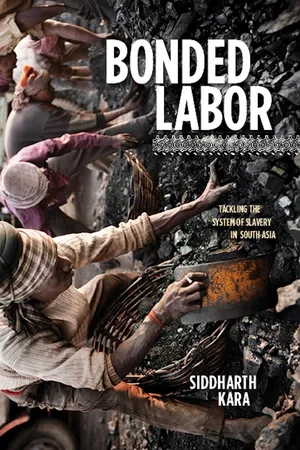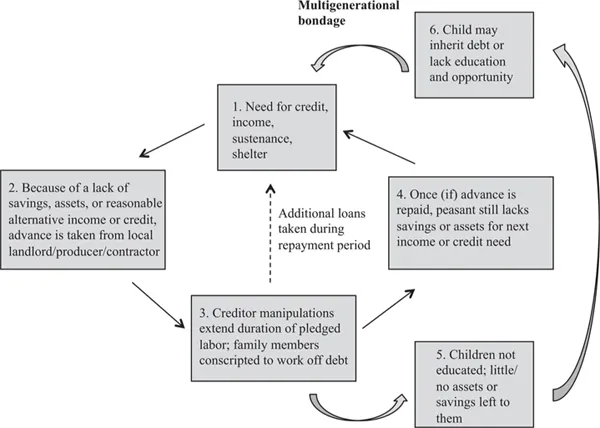
Bonded Labor
Tackling the System of Slavery in South Asia
- English
- ePUB (mobile friendly)
- Available on iOS & Android
About this book
Siddharth Kara's Sex Trafficking has become a critical resource for its revelations into an unconscionable business, and its detailed analysis of the trade's immense economic benefits and human cost. This volume is Kara's second, explosive study of slavery, this time focusing on the deeply entrenched and wholly unjust system of bonded labor.
Drawing on eleven years of research in India, Nepal, Bangladesh, and Pakistan, Kara delves into an ancient and ever-evolving mode of slavery that ensnares roughly six out of every ten slaves in the world and generates profits that exceeded $17.6 billion in 2011. In addition to providing a thorough economic, historical, and legal overview of bonded labor, Kara travels to the far reaches of South Asia, from cyclone-wracked southwestern Bangladesh to the Thar desert on the India-Pakistan border, to uncover the brutish realities of such industries as hand-woven-carpet making, tea and rice farming, construction, brick manufacture, and frozen-shrimp production. He describes the violent enslavement of millions of impoverished men, women, and children who toil in the production of numerous products at minimal cost to the global market. He also follows supply chains directly to Western consumers, vividly connecting regional bonded labor practices to the appetites of the world. Kara's pioneering analysis encompasses human trafficking, child labor, and global security, and he concludes with specific initiatives to eliminate the system of bonded labor from South Asia once and for all.
Frequently asked questions
- Essential is ideal for learners and professionals who enjoy exploring a wide range of subjects. Access the Essential Library with 800,000+ trusted titles and best-sellers across business, personal growth, and the humanities. Includes unlimited reading time and Standard Read Aloud voice.
- Complete: Perfect for advanced learners and researchers needing full, unrestricted access. Unlock 1.4M+ books across hundreds of subjects, including academic and specialized titles. The Complete Plan also includes advanced features like Premium Read Aloud and Research Assistant.
Please note we cannot support devices running on iOS 13 and Android 7 or earlier. Learn more about using the app.
Information

Table of contents
- Cover
- Half title
- Title
- Copyright
- Dedication
- Epigraph
- Contents
- List of Tables and Figures
- Preface
- Acknowledgments
- 1. Bonded Labor: An Overview
- 2. Agriculture: Kamaiya and Hari
- 3. Bricks and Bidis
- 4. Shrimp and Tea
- 5. Construction and Stonebreaking
- 6. Carpets and Other Sectors
- 7. Bonded Labor and the Law
- 8. Tackling Bonded Labor
- Appendix A. Global Slavery Metrics, 2011
- Appendix B. Select Bonded Labor Economics
- Appendix C. Select Bonded Labor Supply Chains
- Appendix D. Bonded Labor as Defi ned by India’s Bonded Labour System (Abolition) Act, 1976
- Appendix E. Bonded Labor Law and Cases: Pakistan, Nepal, Bangladesh, India
- Appendix F. Select Economic and Human Development Statistics
- Notes
- Works Cited
- Index